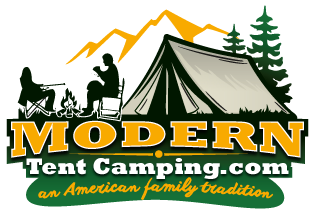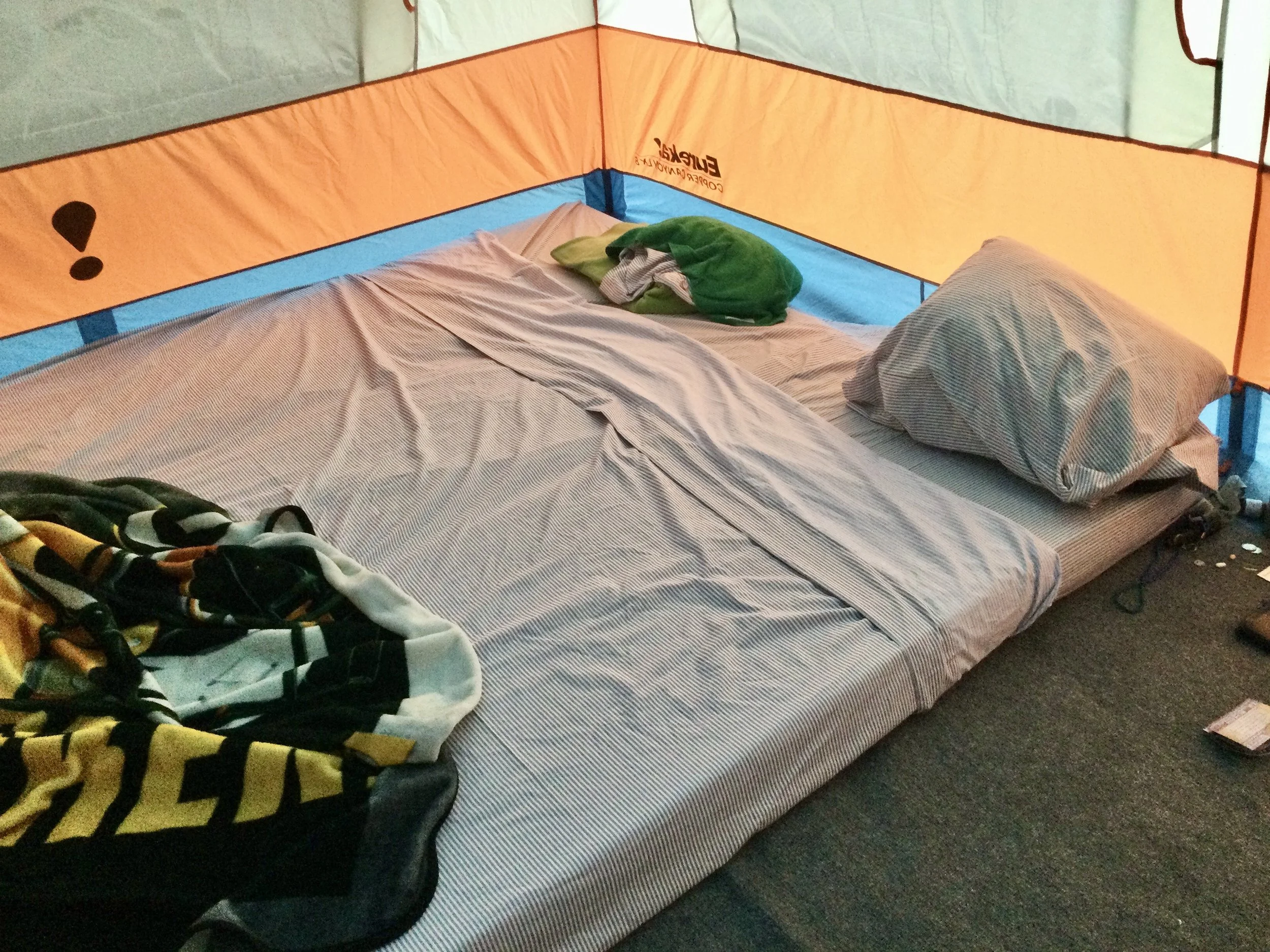Make a Warm and Comfortable Bed
Sleeping well is one of the most important pre-requisites for having an enjoyable camping trip. So, camping families must assemble the items needed to make a warm and comfortable camp bed. When you were young, you could sleep almost anywhere for a night or two - even on the cold hard ground. But as you get older, and as you spend more nights on your camping trips, you will want to make a warm and comfortable bed.
Make a great family tent camping bed
The best family tent camping bed for an individual is a full-sized bed made with two thick, wide, and insulated self-inflating mattresses (SIMs). And the best bed for couples is a king-sized bed made with three of these SIMs. Let me explain how to make these beds.
FLOOR COVERING. First, lay a thin wool or synthetic carpet or blanket on the floor of your tent to absorb moisture and reduce conductive heat loss from the cold ground. This insulated layer will help to make your tent dryer and warmer. We use a small, thin piece of indoor/outdoor carpet from Home Depot. For larger tents, you may need two or three pieces. Foam children mats would also work well. But don’t use moving blankets because they usually are made with cotton batting and, thus, will hold moisture and make you feel colder when wet.
FOUNDATION. For a king-sized bed, place three non-slip foam yoga mats on top of the insulated carpet to make the foundation of your bed. This foundation will provide an extra layer of insulation and comfort. And, should a SIM spring a leak, the yoga mat will provide an adequate amount of comfort for the rest of the night until the SIM can be repaired or replaced.
SELF-INFLATING AIR MATTRESS (SIM). Self-inflating mattresses are a great bedding choice because they are very durable, easy to pack, easy to fit into any sized tent, very warm, and very comfortable. These mattresses typically range in thickness from about 1 inch to about 4 inches, range in lengths up to 6.5 feet, and range in widths up to 30 inches. In general, larger thicker mattresses are warmer and more comfortable - but they are also more expensive. For example, a large good-quality 2-inch thick mattress will cost about $120 while a good 4-inch thick SIM will cost about $240. Perhaps the best known brand is Therm-A-Rest - but REI, Mondo King, and Exped also make very good SIMs. Currently we are using Qumotop mats and like them very much.
As previously noted, SIMs are very durable. With reasonable care, they should last 10 years or longer without springing a leak. They fit into any tent - even small ones and they require very little effort to inflate. Just open a valve and allow the inner foam core to expand and suck in air. No pump is necessary. Furthermore, they are very warm and comfortable. But they do have at least four limitations. First, they are expensive. To make a king-sized bed, you’ll need three of them with a total cost of about $600. Second, they are very low down near the ground and some campers will have difficulty standing up from them. Third, they can be difficult to roll up before each camping trip - especially if they are 4-inches thick. Rolling two or three of these mats can be a dreaded task. And finally, SIMs can spring leaks - so you will need to buy a patch kit and keep it handy for an emergency
LINEN. To hold the bed together and to add additional comfort, cover yoga pads and mattresses with a fitted sheet. Use a king-size sheet for a king size camp bed and a standard-size sheet for a smaller bed. A top sheet and pillow cases will add even more comfort.
CLOTHING. The primary way to maintain body warmth on cool nights is with warm clothing. Begin with a polyester or wool short-sleeve T-shirt and a pair of nylon or polyester shorts. As the temperature drops, add comfortable layers of wool socks, long-sleeve polyester or wool thermal T-shirt, polyester or wool thermal pants, a polyester or fleece hoodie, and polyester athletic pants. The complete combination of these garments with a good synthetic quilt or wool blanket should keep you comfortably warm down to 35 degrees F. Avoid all cotton garments - such as socks, underwear, pajamas, sweat shirts, and sweat pants - because cotton absorbs moisture (sweat) and will chill the body.
COVERS. Large wool or synthetic quilts and blankets are more comfortable than confining sleeping bags and, when combined with warm clothing, provide almost as much warmth. Synthetic quilts or sleeping bags are better than down-filled because they keep you warm when wet and dry faster. Quilts and blankets allow individuals to adjust their body temperature better and allow couples to cuddle. Rectangular sleeping bags, opened up, make excellent family camping quilts because two can be zipped together to make an extra large quilt. Mummy bags do not allow this option and have expensive features that most camping families rarely need. For example, most family tent campers would never use the hoods of mummy bags.
PILLOWS. Pillows add immensely to your sleeping comfort and should be included in any sleeping system. Car camping families have many options. You can pack small travel pillows or just cover soft, clothing-filled duffel bags with pillow cases.
Make a warm and comfortable double bed with two foam yoga mats and two thick & wide self-inflating mattresses (SIMs).
Wear warm clothes in cool weather.
The Teton Sports Outfitter XXL cot is very strong.
Many people like air beds. Buy two singles rather than a queen size.
Cots
Many camping families prefer cots, primarily because they are higher off the ground - and, thus, make it easier to stand up. And, this advantage gets more and more appealing as you grow heavier and older. Furthermore, cots offer some underneath storage area for your clothing and personal items.
But cots have several disadvantages that should be considered before selecting them as your sleeping system. First, cots can be very cold in moderately cool weather. Thus, you should buy an insulated blanket or pad to place on top of the cot to sleep on. Second, cots require considerable packing space and two or three would be almost impossible to pack in a car with all your other camping gear. Third, cots require considerable set-up space so you would need an 8-person tent or larger for 2 cots. It would be very hard to set up 2 cots in a smaller tent. Fourth, cots have several hinged parts and sharp edges that can pinch or smash your hands when setting it up or folding it up. Fifth, when set up, cots have hard protruding corners that can bust your shins - especially when walking around in the tent after dark. Sixth, cot legs can quickly wear or tear holes in your tent floor so you you would need to buy an extra thick carpet to protect the floor. If you decide to buy cots, be sure to note their weight limitations. Many cots are not strong enough to support heavy people.
Air Beds
Many camping families, including several of my friends, prefer inflatable air beds. Some advantages of these air beds are: they are higher than SIMs and some are just as high as cots; they are less expensive than than SIMs and cots; they require less packing space than cots; and they allow couples to have physical contact during the night.
But they also have a few limitations that should be considered before choosing this sleeping system option. First, they are not insulated and, thus, can be very cold in cool weather. So, you would need an insulated cover or heated mattress cover to assure sufficient warmth every night. Second, they require a pump that could get lost or damaged. Furthermore, this pump may require electrical service. Consequently, in some camping areas, it may be hard to inflate the bed. Third, air beds usually leak and must be re-inflated often. Fourth, they require larger tents; two beds will not fit into smaller 2 and 4-person tents. Fifth, cheaper beds may not be strong enough to support heavier campers. And finally, they are bouncy. So each camper should have his or her own bed rather than trying to share a king or queen-sized bed. So, considering all these factors, a pair of air beds, with needed accessories, will also be expensive.
Hammocks
Many young backpackers like to sleep in hammocks because they are reasonably comfortable, lightweight, require minimal packing space, and can be hung on rough, steeply-sloped ground and across small streams. We also pack two hammocks for most camping trips and enjoy taking frequent naps in them. Sometimes, I’ll fall asleep in mine early in the evening and sleep there several hours before getting up in the middle of the night and going into our tent to sleep the rest of the night.
But hammocks have several limitations that should be considered before adopting them as your primary sleeping system. For example, some developed campgrounds (especially in Florida) do not allow campers to hang hammocks on trees and other campgrounds only allow hammocks to be hung with extra wide straps. Second, many campsites do not have two or three conveniently spaced trees for hanging hammocks. Third, and most important for me, is that hammocks are not comfortable for long night sleeping and multi-night trips. They do not allow me to change my sleeping position as easily as I would like. Perhaps this is due to my weight and age. Younger thinner campers perhaps would be more comfortable. Fourth, hammocks are cold in cool weather and so you must buy an under quilt and or a sleeping pad. Fifth, most hammocks do not have mosquito netting and thus, netting must be purchased and added to the hammock system. Sixth, it can be difficult getting into a hammock that has an under quilt, insulated sleeping pad, tarp cover, mosquito netting, and sleeping bag. Seventh, many trees and forrest floors have poison ivy that could brush against your feet, legs, hands, and arms when getting into or out of a hammock. And finally, hammocks do not provide a comfortable escape from cold and rainy weather.
Describes how to make a warm and comfortable camp bed.





